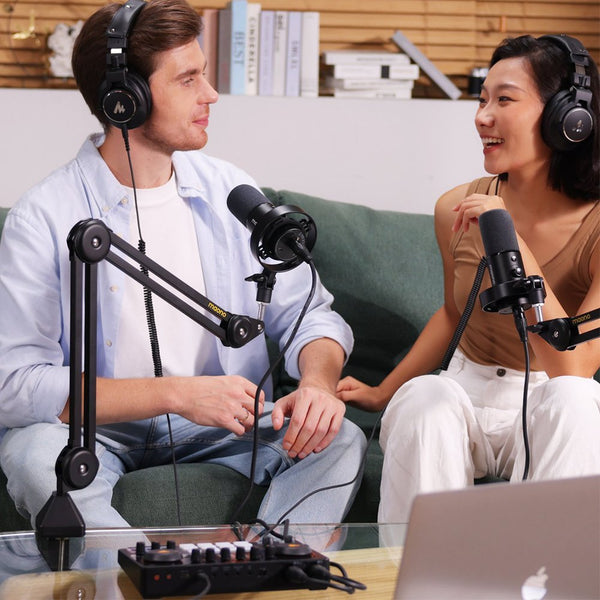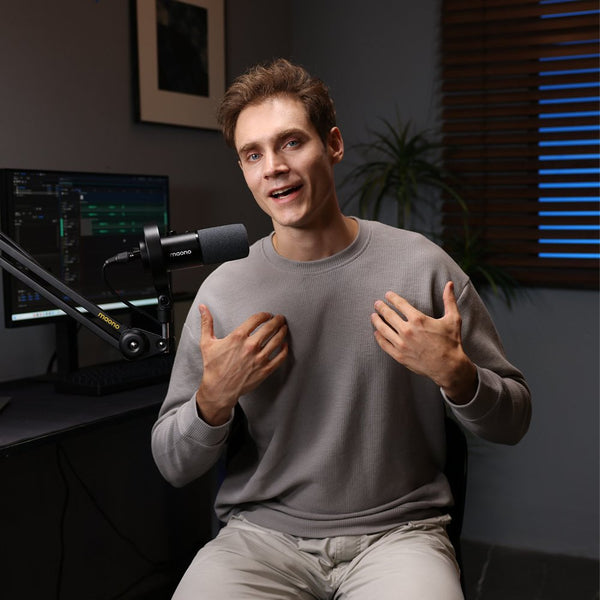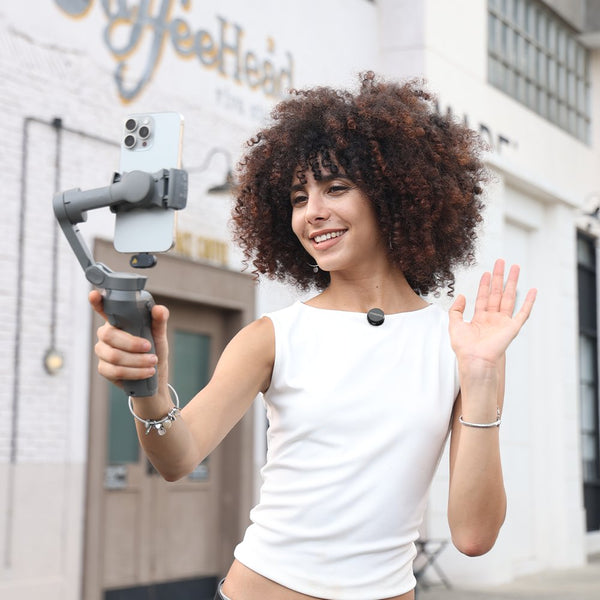Trying to choose between a condenser microphone and a wireless microphone for recording music covers but not sure which one to pick? I hope this guide helps—keep reading.
In today’s digital age, singing covers on Facebook has become a powerful way for aspiring vocalists to showcase their talent. Whether you’re streaming live or uploading pre-recorded performances, audio quality is a key element that can make or break your content. Two popular options for capturing vocals are lavalier microphones and condenser microphones—but which one is best for your Facebook music covers?
This guide compares both mic types in detail, covering audio clarity, usability, setup, and performance. We’ll also answer the most common questions creators ask when deciding between these two microphones and recommend top budget picks: the Maono Wave T5 lavalier mic and the Maono PM422 recommended condenser microphone.
Lavalier Mic vs. Condenser Mic for Facebook Music Covers
Lavalier microphones (or “lav mics”) are compact, clip-on mics often used in interviews, presentations, and video recordings where mobility and discreet design are essential. On the other hand, condenser microphones are studio favorites known for their sensitivity, vocal richness, and detailed sound capture. Many professionals even refer to them as the best microphone condenser for vocals due to their precision and tonal quality.
When choosing the right mic for Facebook covers, the decision ultimately depends on your goals: Do you need convenience and portability, or are you aiming for professional condenser microphone audio quality?
Let’s dive deeper into the key factors that will help you choose the right mic for your Facebook singing journey.
How to Choose a Mic for Vocal Clarity in Facebook Live Covers
Vocal clarity is essential when performing on social platforms. An unclear or muffled sound can turn off your audience—no matter how amazing your vocals are. Here’s how each mic type stacks up:
-
Lavalier Mic for Clarity: These mics are omnidirectional or sometimes cardioid. They sit close to your mouth, which helps reduce room noise. However, they might struggle to capture full vocal dynamics, especially during expressive singing.
-
Condenser Mic for Clarity: Condenser mics, particularly cardioid ones, offer superior sensitivity and a wide frequency response. They reproduce rich, natural vocals, making them perfect for singing covers. In fact, many artists consider them the best condenser mic for vocal-based content on social media platforms.
If clarity and vocal detail are your top priorities—especially in an indoor, controlled environment—a condenser microphone is the better option.
Pros and Cons of Lavalier Mics for Singing Covers

Lavalier mics come with unique advantages but also limitations when it comes to recording music.
✅ Pros of Lavalier Mics
-
Compact and lightweight
Easy to clip on, perfect for mobile or casual setups.
-
Hands-free recording
Allows full freedom of movement while singing or playing instruments.
-
Wireless options
Great for live streaming without being tied to a mic stand.
-
Phone compatibility
Many lav mics connect directly to smartphones.
❌ Cons of Lavalier Mics
-
Limited vocal detail: May not capture the full dynamic range of vocals.
-
Sensitive to clothing rustle: Poor placement can lead to unwanted noise.
-
Less ideal in noisy environments: Unless noise reduction is built-in, ambient noise can be an issue.
-
Not ideal for post-processing: Lower signal quality makes editing trickier.
Still, if you're streaming outdoors or need to move while performing, a wireless lav mic like the Maono Wave T5 can provide impressive audio with great portability.
How Condenser Mics Improve Facebook Cover Song Quality

Condenser microphones are the go-to choice for most vocal recordings—and for good reason.
Benefits of Using a Condenser Mic
-
Exceptional sensitivity
Picks up subtle nuances, making vocals sound fuller and more expressive.
-
Wide frequency range
Captures both low and high frequencies accurately.
-
Studio-level sound
Perfect for voice isolation and background noise control.
-
Rich tone quality
Great for showcasing singing techniques like vibrato, falsetto, or dynamic range shifts.
A USB condenser mic like the Maono PM422 provides excellent audio without the need for extra gear. With built-in gain control, a shock mount, and a pop filter, it's tailored for vocal recording—even in untreated rooms. It’s a recommended condenser microphone for creators who want professional results without studio complexity.
Common Questions About Lavalier vs. Condenser Mics for Singing
1. Which mic gives better sound quality for singing—lavalier or condenser?
Condenser microphones generally offer better sound quality due to their sensitivity and wide frequency response. Lavalier mics are more practical but not designed for capturing professional condenser microphone vocal performance.
2. Is a lavalier microphone good enough for recording music covers on Facebook?
For casual, mobile, or live-streamed content, yes. But for serious vocal performance, you may notice limitations in richness and clarity.
3. Can you record studio-like vocals with a lavalier microphone?
Not quite. While high-end lavaliers can sound decent, they lack the depth and presence of a condenser mic. Studio-level vocals require a mic like the Maono PM422, a best condenser mic choice for Facebook content creators.
4. Why do most singers prefer condenser mics over lav mics?
Condenser mics deliver superior vocal fidelity, dynamic range, and tone control. They’re more suited to detailed vocal expression.
5. What are the audio differences between a lav mic and a condenser mic?
Lav mics often have a limited dynamic range and can sound flat, while condenser mics produce richer, warmer, and more natural vocals.
6. Are wireless lavalier microphones suitable for live singing?
They are suitable for live streaming casual performances, especially when movement is involved. However, they may not handle high vocal volumes or complex dynamics well.
7. What is the best budget mic for singing covers on Facebook?
-
Lavalier microphone option: Maono Wave T5 – great for mobile or live use.
-
Condenser microphone option: Maono PM422 – ideal for studio-like quality on a budget. It’s a recommended condenser microphone for its value and clarity.
8. Can I connect a lavalier mic directly to my phone for live streaming?
Yes, many lav mics like the Maono Wave T5 come with TRRS adapters or USB-C/lightning connectors for phone compatibility.
9. Which microphone is better for recording in untreated rooms?
Cardioid condenser mics like the PM422 are better at focusing on vocals and rejecting room echo—especially when used with a pop filter and shock mount.
10. How do lav mics and condenser mics compare in low-light, casual settings?
Lav mics blend into clothing and are great for a clean video frame in casual settings. Condenser mics, while more visible, provide better audio—ideal for higher production value.
Conclusion
When it comes to Facebook music covers, your microphone choice can significantly influence the quality of your performance.
If you're focused on mobility, simplicity, and casual streaming, a wireless lavalier mic like the Maono Wave T5 is a great pick. It's budget-friendly, mobile-friendly, and works well in dynamic environments.
However, if you're looking for studio-quality sound, vocal richness, and a more professional condenser microphone experience, a USB condenser mic like the Maono PM422 is the clear winner. It gives your voice clarity, tone, and warmth that will help you stand out on Facebook. For many creators, it remains a best microphone condenser for vocals—offering professional results at a beginner-friendly price.
Final Tip: Consider your environment, vocal style, and video setup before making your choice. Whether you're just starting out or building a personal brand, choosing the best condenser mic or a reliable lav mic is a key step toward better engagement and lasting impressions.



